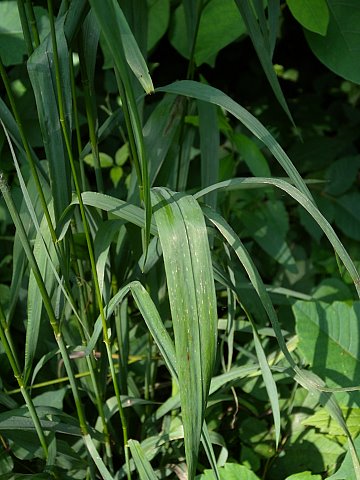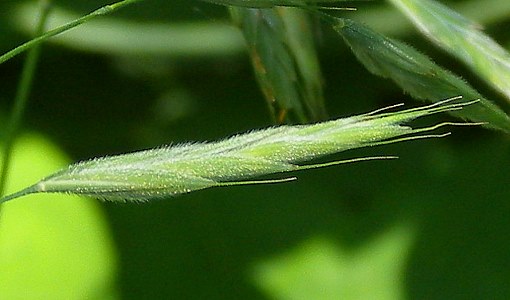
Each fertile culm terminates in a panicle of drooping spikelets about 4-12" long and similarly across; the panicle may have a balanced pyramidal shape or it may droop to one side. Along the central rachis of the panicle, there are whorls of 2-4 lateral branches that divide into branchlets; the rachis, branches, and branchlets are medium to dark green, very slender, and drooping from the weight of the spikelets. The spikelets are 2-3 cm. in length, 4-5 mm. across, and somewhat flattened; immature spikelets are light green or gray-green, while mature spikelets become brown. Each spikelet has a pair of glumes at the bottom and 5-11 awned lemmas that are arranged above into two ranks. The smaller glume is 6-8 mm. long, linear in shape, and single-veined, while the larger glume is 8-10 mm. long, linear-lanceolate in shape, and 3-veined. Both glumes are either glabrous or sparsely short-pubescent and their outer surfaces are convex, rather than keeled. The lemmas are 8-12 mm. in length (excluding their awns), narrowly oblong-elliptic in shape, 5-veined, and convex along their outer surfaces. The lemmas are usually short-pubescent along the entire length of their outer surfaces, sometimes with longer hairs along their margins. On rare occasions, the lemmas are glabrous. The awns of the lemmas are 3-6 mm. in length and straight. Each fertile lemma has a floret with a pair of feathery stigmata, 2-3 anthers, and a developing ovary. The blooming period occurs from late spring to mid-summer, lasting about 1-2 weeks. The florets are wind-pollinated. Afterwards, the lemmas disarticulate from the spikelets above the glumes, dispersing their elongated grains. The root system is fibrous.

Cultivation: This grass prefers partial sun to light shade, moist to mesic conditions, and soil containing fertile loam, silt-loam, or sandy loam. It is one of the taller grasses with some tolerance of shade.
Range & Habitat: The native Hairy Woodland Brome is fairly common throughout Illinois (see Distribution Map). Habitats include rich mesic woodlands, woodlands and savannas along rivers, disturbed open woodlands, thickets, woodland borders, and edges of swamps. This grass is usually found in bottomland or floodplain areas where various deciduous trees are dominant. It is rarely found in open areas.
Faunal Associations: Insects that feed on woodland brome grasses are poorly documented, but they may include the following two species: leaf-mining larvae of the leaf beetle, Chalepus walshii, and leaf-mining larvae of the moth, Elachista illectella. Some vertebrate animals that feed on the seeds of these grasses include the Ruffed Grouse, Wild Turkey, various sparrows, and the White-Footed Mouse. Vertebrate animals that feed on the foliage include the White-Tailed Deer (during fall & winter) and Cottontail Rabbit (young foliage). The foliage is also palatable to domesticated farm animals (cattle, horses, etc.) when it is young. There is also a record that lists brome grass as a food plant of the Eastern Box Turtle (Ernst et al., 1994), which is found in habitats that are similar to Hairy Woodland Brome.

Photographic Location: Edge of a bottomland woodland at the Indiana Dunes National Lakeshore in NW Indiana.
Comments: This is a tall lanky grass with drooping spikelets and the most common native brome grass in Illinois. The hairiness of individual plants is rather variable across local populations. The taxonomic history of this species has been unstable; this grass has been referred to as Bromus canadensis and Bromus purgans in the past. Hairy Woodland Brome is very similar to Fringed Woodland Brome (Bromus ciliatus) and Leafy Woodland Brome (Bromus purgans). These are all native species that occupy similar habitats. Fringed Woodland Brome can be distinguished by its lemmas, which have hairs along the lower two-thirds of their margins, otherwise its lemmas are glabrous. Leafy Woodland Brome can be distinguished from the preceding two species by the abundance of leaves along its culms (typically 9-15 per culm). It is also possible to encounter plants that display mixed characteristics of the preceding species. Such plants may be naturally occurring hybrids.